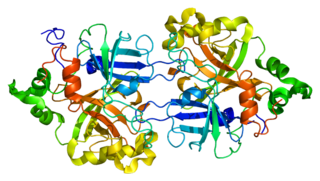
Tannins are a class of astringent, polyphenolic biomolecules that bind to and precipitate proteins and various other organic compounds including amino acids and alkaloids.

Schinopsis balansae is a hardwood tree known as willow-leaf red quebracho which forms forests in the subtropical Humid Chaco ecoregion of north-eastern Argentina, and Paraguay. It is also found in the wild Pantanal vegetation in Brazil. Some of its vernacular names are quebracho colorado chaqueño and quebracho santafesino. Other species, like Schinopsis lorentzii, bear the general name quebracho and have similar properties and uses. S. balansae shares its habitat with a species of the same genus, S. heterophylla, and the two are often confused.

The Biochemical Journal is a peer-reviewed scientific journal which covers all aspects of biochemistry, as well as cell and molecular biology. It is published by Portland Press and was established in 1906.
Proanthocyanidins are a class of polyphenols found in many plants, such as cranberry, blueberry, and grape seeds. Chemically, they are oligomeric flavonoids. Many are oligomers of catechin and epicatechin and their gallic acid esters. More complex polyphenols, having the same polymeric building block, form the group of tannins.

Complement factor B is a protein that in humans is encoded by the CFB gene.

Acacia mearnsii, commonly known as black wattle, late black wattle or green wattle, is a species of flowering plant in the family Fabaceae and is endemic to south-eastern Australia. It is usually an erect tree with smooth bark, bipinnate leaves and spherical heads of fragrant pale yellow or cream-coloured flowers followed by black to reddish brown pods. In some other parts of the world, it is regarded as an invasive species.

Procyanidins are members of the proanthocyanidin class of flavonoids. They are oligomeric compounds, formed from catechin and epicatechin molecules. They yield cyanidin when depolymerized under oxidative conditions.

William John Young was an English biochemist.
The enzyme acetylesterase (EC 3.1.1.6) catalyzes the reaction

Aspalathin is a C-linked dihydrochalcone glucoside found in rooibos tea, a herbal tea prepared from the South African rooibos plant, Aspalathus linearis (Fabaceae).

Digallic acid is a polyphenolic compound found in Pistacia lentiscus. Digallic acid is also present in the molecule of tannic acid. Digalloyl esters involve either -meta or -para depside bonds.

Fisetinidin is an anthocyanidin. It has been obtained from the heartwood of Acacia mearnsii, from the bark of Rhizophora apiculata and can also be synthesized. Fisetinidin is very similar in structure to fisetin, which itself differs in structure from quercetin only by an additional hydroxyl group on the latter.

Leucoanthocyanidin (flavan-3,4-diols) are colorless chemical compounds related to anthocyanidins and anthocyanins. Leucoanthocyanins can be found in Anadenanthera peregrina and in several species of Nepenthes including N. burbidgeae, N. muluensis, N. rajah, N. tentaculata, and N. × alisaputrana.
Quebracho[keˈβɾatʃo] is a common name in Spanish to describe very hard wood tree species. The etymology of the name derived from quiebrahacha, or quebrar hacha, meaning "axe-breaker". The corresponding English-language term for such hardwoods is breakax or breakaxe.

Condensed tannins are polymers formed by the condensation of flavans. They do not contain sugar residues.
The Colworth Medal is awarded annually by the Biochemical Society to an outstanding research biochemist under the age of 35 and working mainly in the United Kingdom. The award is one of the most prestigious recognitions for young scientists in the UK, and was established by Tony James FRS at Unilever Research and Henry Arnstein of the Biochemical Society and takes its name from a Unilever research laboratory near Bedford in the UK, Colworth House.
Edgar Charles Bate-Smith (1900-1989) was an English chemist and phytochemist specialising in food chemistry. He worked in the Low Temperature Research Station in Cambridge where his main fields of research were meat and polyphenols.

Quentin Howieson Gibson FRS was a Scottish American physiologist, and professor at the University of Sheffield, and Cornell University.
Maximilian Nierenstein was a professor of biochemistry at the University of Bristol.

Luteic acid is a natural phenol found in numerous fruits. It is a monolactonized tergalloyl group. Maximilian Nierenstein showed in 1945 that luteic acid was a molecule present in the myrobalanitannin, a tannin found in the fruit of Terminalia chebula and is an intermediary compound in the synthesis of ellagic acid. It can form from hexahydroxydiphenic acid. It is also present in the structure of the tannins alnusiin and bicornin.














